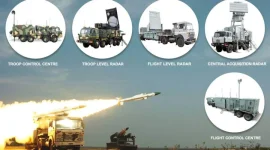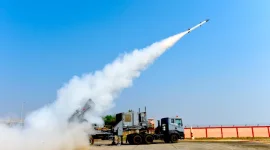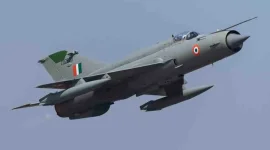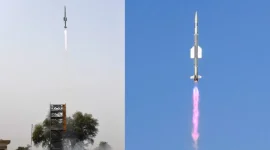- Views: 3K
- Replies: 13
Following the demonstrated effectiveness of indigenous Akash and Medium-Range Surface-to-Air Missile (MR-SAM) systems in recent Indo-Pakistan clash, India's Ministry of Defence (MoD) is reportedly shifting its focus towards bolstering its capabilities against emerging low-altitude aerial threats, particularly unmanned systems.
This strategic pivot involves the prioritised acquisition of Very Short-Range Air Defence Systems (VSHORADS), Vertically Launched Short-Range Surface-to-Air Missiles (VL-SRSAM), and Quick Reaction Surface-to-Air Missiles (QRSAM).
These advanced missile systems are intended to provide a robust defence mechanism against a spectrum of aerial challenges, including hostile drones, Unmanned Aerial Vehicles (UAVs), and potentially manned aircraft operating at lower altitudes. The move underscores a proactive approach to the evolving nature of aerial warfare.
The Akash missile system, developed by the Defence Research and Development Organisation (DRDO), is a medium-range, surface-to-air missile that can engage multiple targets simultaneously up to a range of about 25-30 kilometres.
Similarly, the MR-SAM, a collaborative project between India's DRDO and Israel Aerospace Industries (IAI), also known as Barak-8, has proven its mettle in providing reliable air defence cover with an reported interception range of up to 70-100 kilometres.
The success of these systems against Pakistani drones has provided the impetus for India to enhance its air defence umbrella, particularly at the lower tiers.
The Ministry of Defence aims to fortify the nation's air defence architecture to counter the increasing prevalence of cost-effective and agile aerial platforms such as drones and UAVs.
These systems have become a significant feature in modern conflicts worldwide, often used for surveillance, reconnaissance, and direct attack roles, posing a challenge to traditional air defence structures.
To address these specific threats, the VSHORADS are being acquired to equip ground forces with a highly portable and rapidly deployable solution for engaging low-flying targets at very short ranges.
The VL-SRSAM, also a DRDO-developed system based on the Astra mk1 missile, offers 360-degree engagement capability due to its vertical launch configuration, providing enhanced flexibility against various aerial threats, including sea-skimming anti-ship missiles, UAVs, and helicopters, with a reported range of around 40-50 km.
The QRSAM, another indigenous system by DRDO, is designed for rapid engagement of aerial targets, including aircraft, helicopters, and precision-guided munitions, offering a quick reaction defence shield for mobile army formations. The QRSAM system can engage targets on the move and has a stated range of up to 30 km.
According to defence analysts, the procurement strategy for these systems is likely to involve a combination of indigenous development, led by organisations like DRDO and public sector undertakings, alongside potential collaborations with international partners to ensure timely acquisition and technology infusion.
This focus on advanced short-range air defence systems is integral to India's broader strategic objective of establishing a comprehensive, multi-layered air defence network.
Such a network is deemed crucial for safeguarding national assets and maintaining security in the strategically vital Indo-Pacific region, which faces a diverse array of aerial threats.
The successful development and induction of these systems will significantly enhance India's tactical air defence capabilities.




